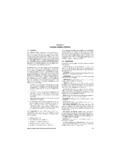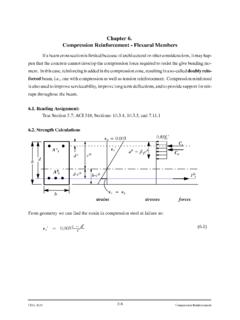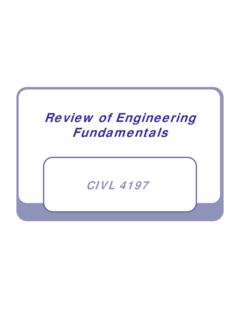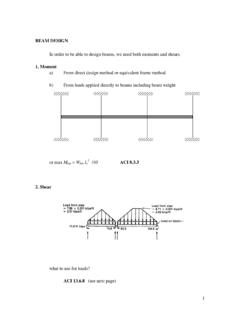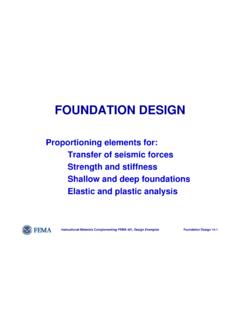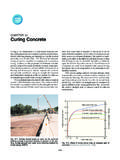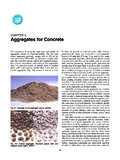Transcription of 5 Aleatory Variability and Epistemic Uncertainty
1 5-15 Aleatory Variability and Epistemic UncertaintyAleatory Variability and Epistemic Uncertainty are terms used in seismic hazard analysisthat are not commonly used in other fields, but the concepts are well Variability is the natural randomness in a process. For discrete variables, therandomness is parameterized by the probability of each possible value. For continuousvariables, the randomness is parameterized by the probability density Uncertainty is the scientific Uncertainty in the model of the process. It is due tolimited data and knowledge. The Epistemic Uncertainty is characterized by alternativemodels. For discrete random variables, the Epistemic Uncertainty is modelled byalternative probability distributions.
2 For continuous random variabiles, the epstemicuncertainty is modelled by alternative probability density functions. In addition, there isepistemic Uncertainty in parameters that are not random by have only a single correct (butunknown) terms randomness and Uncertainty have also been used for Aleatory Variability andepistemic Uncertainty , respectively; however, these terms are commonly used in genericways. As a result, they are often mixed up when used in hazard analysis. The terms Aleatory Variability and Epistemic Uncertainty do not roll off the tongue easily. Thisunfamiliarity causes people to stop and think about what they are trying to say beforeusing them.
3 The overall goal is to have a clear terminology that will Example of the Unknown DieAs a simple example, consider the problem of rolling a die. Assume that you have notseen the die, but you have seen the results of four previous rolls. Those four previousrolls came up 2, 3, 3, and 4. What is the model for this die?5-2As one approach to developing a model, you may consider that although there are onlyfour observations from this die, you have previous experience with dice. Most dice havesix sides that are equally likely. The sparse data set is consistent with a standard die. Soyou construct a model of the die in which the Aleatory is given by a uniform distributionwith values between 1 and 6 (model 1 in Table 5-1).
4 An alternative approach to developing the model could be purely empirical. Given thefour observations are all between 2 and 4, you could develop a model that assumes thatthis is a five-sided loaded die so that it comes up 3 most often, 2 and 4 less often, and 1and 5 least often. This model is shown as model 2 in Table one of these two models is correct? We don t know until additional data iscollected ( more rolls of the die). With time, as more rolls of the die becomeavailable, we will be able to distinguish between these two models. These two modelsrepresent Epistemic Uncertainty in the properties of the additional rolls of the die become available, the Aleatory Variability does not go tozero.
5 Rather, our estimate of the Aleatory Variability becomes more accurate. It mayincrease or decrease from our original estimate. In contrast, the Epistemic uncertaintywill go to zero as the number of rolls of the die becomes large. If we had a large enoughnumber of rolls, we could develop a very accurate empirical model of the 5-1. Example of Aleatory Variability and epistemicuncertainty for a die with unknown 1 Model 211 alternative models may not be equally credible. In this example, it may be judged tobe more likely that the die is a standard six-sided die than some special loaded five-sided5-3die. The alternative models are assigned weights using logic trees as discussed in detailin section example demonstrates the situation that is common in developing models forseismic hazard analysis.
6 Often we have a very small amount of data that is from theparticular region under study. The two alternatives are to build a model based on thevery limited, but region-specific data ( model 2 above) or to use a larger set of datafrom regions that we consider to be analogous to the region under study (model 1 above). Is it Aleatory Variability or Epistemic Uncertainty ?The idea of distinguishing between Aleatory Variability and Epistemic Uncertainty soundssimple enough and if seismic hazard analyses were about throwing dice it would be practice, the distinction between Aleatory Variability and Epistemic Uncertainty can distinguishing between Aleatory Variability and Epistemic Uncertainty it can be helpfulto think how you would describe, in words, the parameter under consideration.
7 If theparameter sometimes has one value and sometimes has another values, then it hasaleatory Variability . That is, the Variability is random. If the parameter always has eitherone value or another, but we are not sure which it is, then the parameter has an example, consider a fault with a postulated segmentation point. One model mayconsider that the segmentation point is an impenetrable barrier and an alternative modelmay consider that the segmentation point does not exist. In this case, the existence of thesegmentation point is Epistemic Uncertainty . There are two alternative segmentationmodels for the fault. The fault is either unsegmented or it is segmented and always stopsthe model of the fault segmentation may consider that the segmentation point exists,but only stops some of the ruptures.
8 In this case, there is Aleatory Variability in rupture5-4mode. Sometimes the rupture is stopped at the segmentation point and sometimes therupture breaks through the segmentation point. In this model, the Epistemic Uncertainty isin the probability that the rupture will stop at the segmentation point. For example, onemodel may have a 30% probability that the rupture is stopped at the segmentation point,whereas, another model may have a 10% probability that the rupture is stopped at thesegmentation recurring issue in separating Aleatory Variability and Epistemic Uncertainty concernsthe limits of what could be learned in the future. There is a school of thought that there isno Aleatory Variability in the earthquake process.
9 In principle, earthquakes areresponding to stresses and strains in the earth. Eventually, given enough time, we willcollect enough data to develop detailed models of the earthquake process that give themagnitudes and locations of future earthquakes. Since the earthquake process is in theoryknowable, there is only Epistemic Uncertainty due to our lack of knowledge which will bereduced in similar issue comes up for ground motion attenuation relations. Ground motionattenuation relations typically only use distance from the site to the source to describe thewave propagation. The detailed 3-D structure of the crust is knowable (or empiricalGreen s functions could be collected).
10 In principle, with time, a wave propagation modelcould be determined for each specific source and site. One could argue that thevariability of the ground motion attenuation relation that is due to the complexities of thewave propagation should be Epistemic Uncertainty since it can be determined asadditional data become practise, we have not used this concept of what is potentially knowable long in thefuture in the estimation of Epistemic Uncertainty and Aleatory Variability . Rather, thealeatory Variability is determined in the context of the models and is based on theparameterization used in the model. With this approach, a model that only uses distancefor the wave propagation will include the Variability due to different wave propagationeffects as part of the Aleatory Variability even though it is potentially this approach, the Aleatory Variability can be reduced as additional fixed parametersare added to the model.
